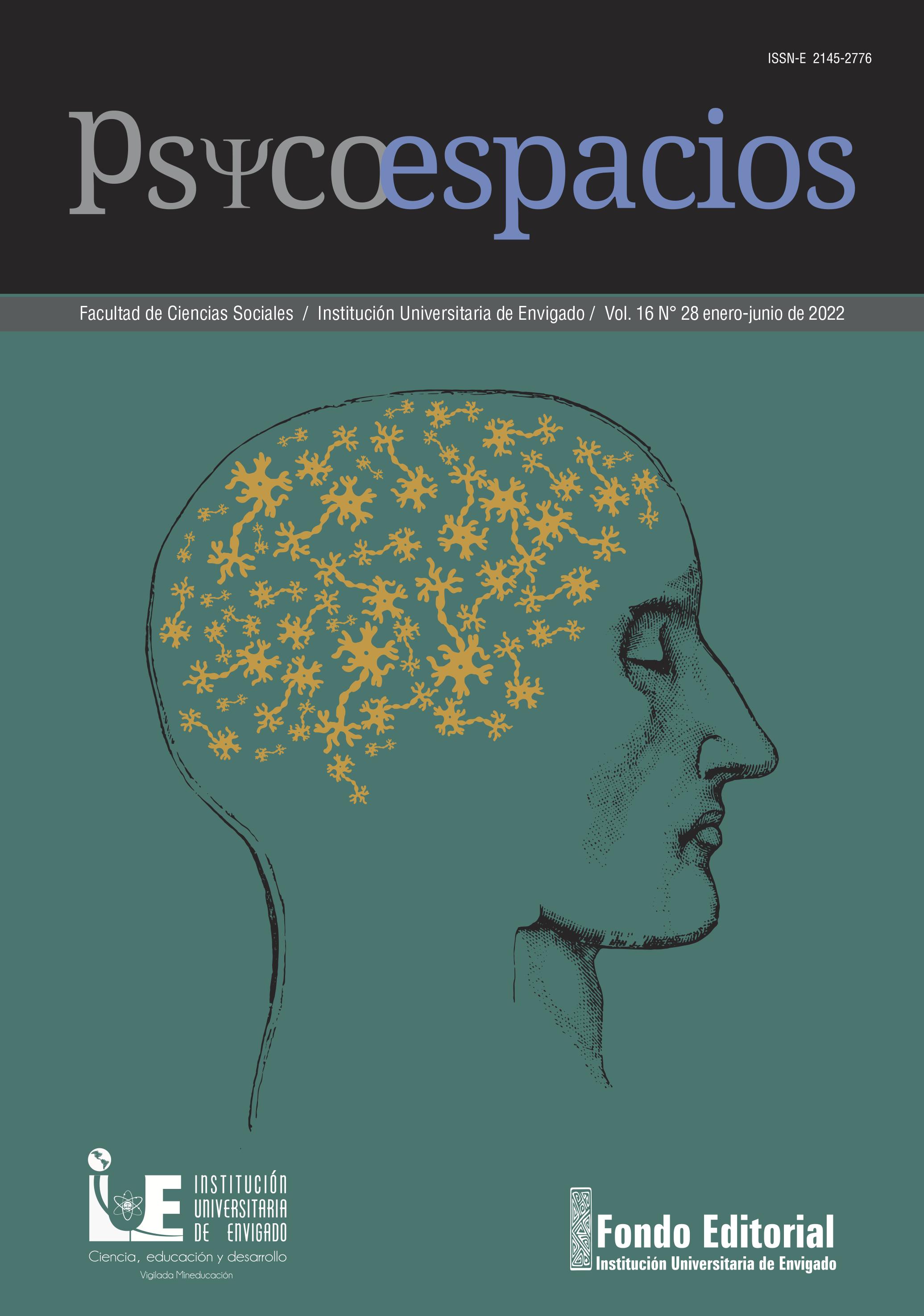The Attentional Process in Body Dysmorphic Disorder
DOI:
https://doi.org/10.25057/21452776.1461Keywords:
body dysmorphic disorder, attention, cognition, dysmorphophobia, mental healthAbstract
This article reflects on the attentional process of people with body dysmorphic disorder. Research antecedents were sought that mentioned results related to the evolution of the classification of the disorder, its prevalence and its relationship with the possible affectations that may occur in the attentional process. It was found that diagnosed individuals may have impairments in attentional and visual processing of face-related information. At the neurophysiological level, there is less activation of the occipital regions and the parietal cortex.
Author Biographies
Jhovani Andrés Ramírez Zuñiga, Universidad Católica Luis Amigó, Colombia
Estudiante de Psicología, Auxiliar Investigativo, Universidad Católica Luis Amigó, Colombia
ORCID: https://orcid.org/0000-0003-2933-1762
Correo electrónico: jhovani.ramirezzu@amigo.edu.co
Melissa Amado Callejas, Universidad Católica Luis Amigó, Colombia
Estudiante de Psicología, Auxiliar Investigativo, Universidad Católica Luis Amigó, Colombia
ORCID: https://orcid.org/0000-0002-3184-0382
Correo electrónico: melissa.amadoca@amigo.edu.co
Dubis Marcela Rincón Barreto, Universidad Católica Luis Amigó, Colombia
Magister en Neuropsicología Clínica, Universidad San Buenaventura, Bogotá. Colombia
Doctorado en Psicología con énfasis en neurociencia cognitiva, Universidad Maimónides, Buenos Aires, Argentina
Coordinadora de la Maestría en Neuropsicopedagogía y del Semillero Adicciones y salud Mental. Universidad Católica Luis Amigó, Colombia
ORCID: https://orcid.org/0000-0002-8322-889X
Correo electrónico: dubis.rinconba@amigo.edu.co
Luisa Fernanda Correa Pérez, Universidad Católica Luis Amigó, Colombia
Maestría en Neuropsicología, Universidad San Buenaventura, Medellín, Colombia
Pregrado en Psicología, Universidad San Buenaventura, Medellín, Colombia
ORCID: https://orcid.org/0000-0001-5053-691X
Correo electrónico: luisa.correape@amigo.edu.co
References
American Psychiatric Association. (2013). Diagnostic and Statistical Manual of Mental Disorders Fifth Edition. American Psychiatric Publishing. https://doi.org/10.1176/appi.books.9780890425596
Angelakis, I.; Gooding, P. A.; Panagioti, M. (2016). Suicidality in Body Dysmorphic Disorder (BDD): A Systematic Review with Meta-analysis. Clinical Psychology Review, v. 49, 55-66. https://doi.org/10.1016/j.cpr.2016.08.002
Behar, R.; Arancibia, M.; Heitzer, C.; Meza, N. (2016). Body Dysmorphic Disorder: Clinical Aspects, Nosological Dimensions and Controversies with Anorexia Nervosa. Revista Médica de Chile, v. 144, n. 5, 626-633. https://doi.org/10.4067/S0034-98872016000500011
Beilharz, F.; Castle, D. J.; Grace, S.; Rossell, S.L. (2017). A Systematic Review of Visual Processing and Associated Treatments in Body Dysmorphic Disorder. Acta Psychiatrica Scandinavica, v. 136, n. 1, 16-36. https://doi.org/10.1111/acps.12705
Benítez Hernández, M. del M.; Rodríguez Testal, J. F.; Núñez Gaitán, M. del C.; Valdés Díaz, M. (2014). Estudio sobre la preocupación por la imagen corporal y la presencia de ideas de referencia: análisis en función del género. http://hdl.handle.net/11441/40795
Bruno, M.; Basabilbaso, J.; Cursack, C. (2013). Un estado del arte sobre estudios neurocientíficos del trastorno obsesivo compulsivo. Cuadernos de Neuropsicología, v. 7, n. 1, 1-12. https://www.cnps.cl/index.php/cnps/article/view/15
Castle, D., Beilharz, F.; Phillips, K. A.; Brakoulias, V.; Drummond, L. M.; Hollander, E.; Ioannidis, K.; Pallanti, S.; Chamberlain, S. R.; Rossell, S. L.; Veale, D.; Wilhelm, S.; Van Ameringen, M.; Dell’Osso, B.; Menchon, J. M.; Fineberg, N. A. (2021). Body Dysmorphic Disorder: A Treatment Synthesis and Consensus on Behalf of the International College of Obsessive-Compulsive Spectrum Disorders and the Obsessive Compulsive and Related Disorders Network of the European College of Neuropsychopharmacology. International Clinical Psychopharmacology, v. 36, n. 2, 61-75. https://doi.org/10.1097/yic.0000000000000342
Cavanna, A. E.; Trimble, M. R. (2006). The Precuneus: A Review of its Functional Anatomy and Behavioural Correlates. Brain: A Journal of Neurology, v. 129, n. 3, 564-583. https://doi.org/10.1093/brain/awl004
Crichton, S. (2020). Reflexionando sobre el trastorno dismórfico corporal. Hannover re. https://www.hannover-re.com/1624210/recent
García, D.; Ojeda, V.; Ferrer, G. (2014). Trastorno dismórfico corporal. Medicentro Electrónica, v. 18, n. 3. http://www.medicentro.sld.cu/index.php/medicentro/article/view/1763
Giraldo-O’Meara, M.; Belloch, A. (2017). El trastorno dismórfico corporal: un problema infradiagnosticado. Revista de psicopatología y psicología clínica, v. 22, n. 1, 69-84. https://doi.org/10.5944/rppc.vol.22.num.1.2017.17929
Grace, S.; Labuschagne, I.; Kaplan, R.; Rossell, S. (2017). The Neurobiology of Body Dysmorphic Disorder: A Systematic Review and Theoretical Model. Neuroscience & Biobehavioral Reviews, v. 83, 83-96. https://doi.org/10.1016/j.neubiorev.2017.10.003
Grace, S.; Lin, W.; Buchananb, B.; Castlec, D; Rossell, S. (2019). Impaired Recognition of Negative Facial Emotions in Body Dysmorphic Disorder. Journal of the International Neuropsychological Society, v. 25, n. 8, 884-889, https://doi.org/10.1017/s1355617719000419
Greenberg, J.; Phillips, K.; Steketee, G.; Hoeppner, S.; Wilhelm, S. (2019). Predictors of Response to Cognitive-Behavioral Therapy for Body Dysmorphic Disorder. Behavior Therapy, v. 50, n. 4, 839-849. https://doi.org/10.1016/j.beth.2018.12.008
He, W.; Shen, C.; Wang, C.; Jia, Y.; Wang, J.; Wang, W. (2018). Body Dysmorphic Disorder Patients: Their Affective States, Personality Disorder Functioning Styles and Body Image Concerns. Personality and Individual Differences, v. 131, n. 1, 1-6. https://doi.org/10.1016/j.paid.2018.04.015
Jefferies-Sewell, K.; Chamberlain, S. R.; Fineberg, N. A.; Laws, K. R. (2017). Cognitive Dysfunction in Body Dysmorphic Disorder: New Implications for Nosological Systems and Neurobiological Models. CNS Spectrums, v. 22, n. 1, 51-60. https://doi.org/10.1017/S1092852916000468
Johnson, S.; Williamson, P.; Wade, T. D. (2018). A Systematic Review and Meta-Analysis of Cognitive Processing Deficits Associated with Body Dysmorphic Disorder. Behaviour Research and Therapy, v. 107, 83-94. https://doi.org/10.1016/j.brat.2018.05.013
Lang, K.; Kerr-Gaffney, J.; Hodsoll, J.; Jassi, A.; Tchanturia, K.; Krebs, G. (2021). Is Poor Global Processing a Transdiagnostic Feature of Body Dysmorphic Disorder and Anorexia Nervosa? A Meta-Analysis. Body Image, v. 37, 94-101. https://doi.org/10.1016/j.bodyim.2021.01.012
Malcolm, A.; Labuschagne, I.; Castle, D.; Terrett, G.; Rendell, P. G.; Rossell, S. L. (2018). The Relationship between Body Dysmorphic Disorder and Obsessive-Compulsive Disorder: A Systematic Review of Direct Comparative Studies. The Australian and New Zealand Journal of Psychiatry, v. 52, n. 11, 1030-1049. https://doi.org/10.1177/0004867418799925
Rincón Barreto, D. M.; Restrepo Escobar, S. M.; Correa Pérez, L. F.; Ospina Duque, J.; Montoya Arenas, D. A. (2019). Trastorno dismórfico corporal: una revisión de las dimensiones clínicas, neurobiología y neuropsicología. Cuadernos Hispanoamericanos de Psicología, v. 19, n. 1, 1-16. https://masd.unbosque.edu.co/index.php/CHP/article/view/3133
Veale, D.; Bewley, A. (2015). Body Dysmorphic Disorder. BMJ, v. 18, n. 350, 2278. https://doi.org/10.1136/bmj.h2278
How to Cite
Downloads
Published
Issue
Section
License
Copyright (c) 2022 Institución Universitaria de Envigado

This work is licensed under a Creative Commons Attribution-NonCommercial-ShareAlike 4.0 International License.

| Article metrics | |
|---|---|
| Abstract views | |
| Galley vies | |
| PDF Views | |
| HTML views | |
| Other views | |




